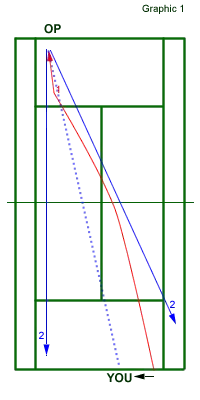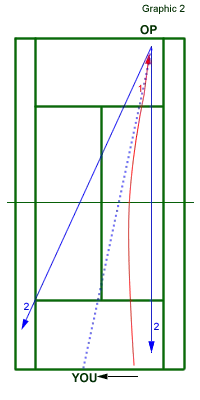Let’s say that you just delivered a ball cross-court and your opponent is just about to hit it from the baseline, close to his right singles sideline. You are on the baseline also, the opposite side (see graphic 1).

To be in the best position for the next shot, you should consider the following:
– if your opponent decides to hit down-the-line, the ball will end up inside your left singles sideline and you should meet the ball also inside the line.
– if your opponent decides to go cross-court, then the trajectory of the ball will intersect your right singles sideline and as a result, your contact with the ball will be in the doubles alley (outside the court). (see graphic 1 above)
So, considering these facts, covering the court properly, from the baseline, means you position yourself halfway between your opponent’s two possible options: down-the-line and cross-court.
As you see, the middle line that goes between the two possible shots intersects the baseline just off the center to the right (in this case). So covering the court by standing at the baseline center would not be a good idea because you will have a hard time (have to run faster and use more energy) getting to the cross-court shot coming your way.
The same happens if you decide to deliver your shot down-the-line:
– you will have to move just beyond the center line and position yourself so that you are equally between the possible down-the-line and cross-court coming from the other player (see graphic 2 below).

Also, it’s very important to understand that by hitting cross-court (from the baseline) you will be in a better position to cover the next shot (graphic 1) compared to going down-the-line (graphic 2) where you will have to run past the center baseline to wait for the next ball.
That makes the cross-court shots better choices if you are tired, want to pace yourself, and just to be in a better position to cover the next ball.
Choose to go down-the-line mostly if that means taking on your opponent’s weak side, if the court is more open there or if you intend to approach.
When moving up to the net, approaching down-the-line is important to consider. (see Court Coverage – playing at the Net)
Now, I can hear you asking: how far from the center baseline should I position myself to cover the court? The answer is subjective to how far your shot pushes the opponent off the court, how deep or short your ball lands, etc. Bottom line is that you should position yourself so that if your opponent is hitting the ball from his right side, you should be just off to the right of your baseline center; the same applies to the left. It will come with experience… the more matches you play the more you will feel the proper distance and position related to the ball on the other side.
Where do you position yourself when the ball is in the middle of the court on the other side? Answer: At the baseline center on your side (see graphic 3).

How to use court coverage to your advantage?
– first, position yourself off to the side where the possible cross-court shot might come from your opponent (cover the cross-court)
– second, hit most of your shots cross-court since you will not have to go too far to recover for the next shot.
You will run less this way and have more time to get in position especially if you were pushed wide and had to reach for the ball.